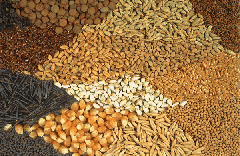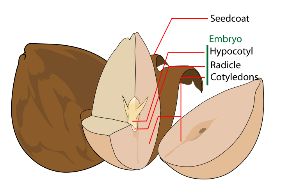Difference between revisions of "Seeds"
m |
m |
||
| Line 8: | Line 8: | ||
}} | }} | ||
==Description== | ==Description== | ||
| − | + | A seed is a small embryonic plant enclosed in a covering called the seed coat, usually with some stored food. It is the product of the ripened ovule of gymnosperm and angiosperm plants which occurs after fertilization and some growth within the mother plant. The formation of the seed completes the process of reproduction in seed plants (started with the development of flowers and pollination), with the embryo developed from the zygote and the seed coat from the integuments of the ovule. All seeds are different size, shape and colour.<br><br> | |
| − | + | Seeds have been an important development in the reproduction and spread of flowering plants, relative to more primitive plants such as mosses, ferns and liverworts, which do not have seeds and use other means to propagate themselves. This can be seen by the success of seed plants (both gymnosperms and angiosperms) in dominating biological niches on land, from forests to grasslands both in hot and cold climates.<br><br> | |
| − | [[File:Seeds-2.jpg]] | + | The term "seed" also has a general meaning that antedates the above—anything that can be sown, e.g. "seed" potatoes, "seeds" of corn or sunflower "seeds". In the case of sunflower and corn "seeds", what is sown is the seed enclosed in a shell or husk, whereas the potato is a tuber.<br><br> |
| + | A typical seed includes three basic parts: (1) an embryo, (2) a supply of nutrients for the embryo, and (3) a seed coat.<br><br> | ||
| + | [[File:Seeds-2.jpg]]<br><br> | ||
[[Category:Products]] | [[Category:Products]] | ||
[[Category:Seeds and agriproducts]] | [[Category:Seeds and agriproducts]] | ||
Revision as of 10:59, 5 August 2014
| Infobox on Seeds | |
|---|---|
| Example of Seeds |  |
| Facts | |
| Origin | - |
| Stowage factor (in m3/t) | - |
| Humidity / moisture | - |
| Ventilation | - |
| Risk factors | See text |
Seeds
Contents
Description
A seed is a small embryonic plant enclosed in a covering called the seed coat, usually with some stored food. It is the product of the ripened ovule of gymnosperm and angiosperm plants which occurs after fertilization and some growth within the mother plant. The formation of the seed completes the process of reproduction in seed plants (started with the development of flowers and pollination), with the embryo developed from the zygote and the seed coat from the integuments of the ovule. All seeds are different size, shape and colour.
Seeds have been an important development in the reproduction and spread of flowering plants, relative to more primitive plants such as mosses, ferns and liverworts, which do not have seeds and use other means to propagate themselves. This can be seen by the success of seed plants (both gymnosperms and angiosperms) in dominating biological niches on land, from forests to grasslands both in hot and cold climates.
The term "seed" also has a general meaning that antedates the above—anything that can be sown, e.g. "seed" potatoes, "seeds" of corn or sunflower "seeds". In the case of sunflower and corn "seeds", what is sown is the seed enclosed in a shell or husk, whereas the potato is a tuber.
A typical seed includes three basic parts: (1) an embryo, (2) a supply of nutrients for the embryo, and (3) a seed coat.












